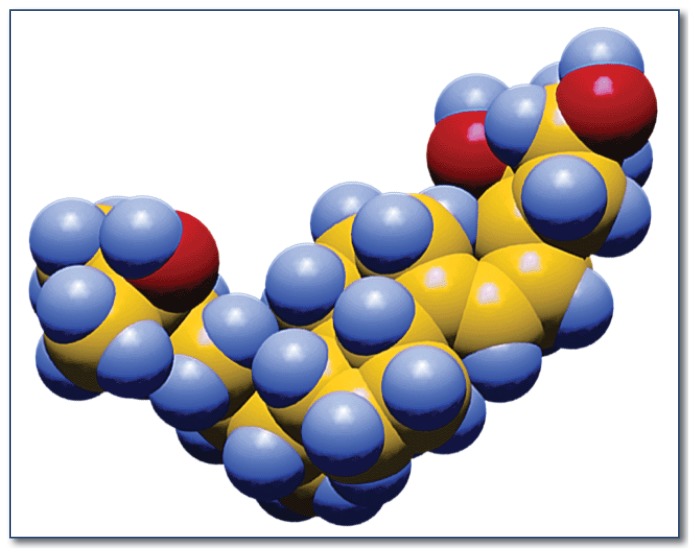Abstract
Obesity and vitamin D deficiency represent two of the most wide-spread health concerns in the United States, especially among children. There is a well-established inverse relationship between vitamin D status and obesity; however, it is unknown as to whether vitamin D deficiency contributes to, or is a consequence of obesity. Based on available research, the positive effects of correcting hypovitaminosis D in obesity seem to be primarily related to its action on glycemic control.
Introduction
The classical and most widely understood biological functions of vitamin D involve calcium homeostasis and bone mineralization; however, vitamin D is also necessary for many other cellular processes and vitamin D receptor (VDR) has been identified in nearly every cell type.1 Data accumulated over the last decade have lead researchers to speculate that the vitamin D deficiency epidemic may be a major contributor to many obesity-associated complications such as the metabolic syndrome and diabetes. Moreover, epidemiological and clinical studies show that the obese have lower vitamin D status; while other trials have indicated that obese individuals with better vitamin D status may respond to an energy-restricted diet more favorably (more body fat loss) than obese with poor vitamin D status.2,3 The purpose of this review is to explore the recent advances in our understanding of the roles vitamin D may play in obesity and obesity-associated metabolic conditions with a particular emphasis on pediatric obesity.
Pediatric Obesity and Vitamin D Deficiency Defined
Obesity is defined as having excess body fat and the most common metric used in its assessment is body mass index (BMI, weight in kilograms divided by the square of height in meters). Although the diagnostic cutoffs are somewhat controversial, the Centers for Disease Control considers a BMI greater than or equal to the 95th percentile on the BMI-for-age growth charts to be indicative of pediatric obesity.4
Vitamin D status is assessed by measuring serum concentrations of 25 hydroxyvitamin D (25(OH)D). Traditionally, vitamin D deficiency, or hypovitaminosis D, has been defined as a 25(OH)D concentration of <20 ng/mL, however recently, an additional classification of “insufficiency” was proposed at a Vitamin D Workshop and elaborated by Grant and Holick; it is defined as 20–32 ng/mL (sufficient is defined as 33–100 ng/mL).5,6
Independently, both pediatric obesity and vitamin D deficiency have been classified as epidemics in the United States (U.S.) population. Data from the NHANES 2009–10 survey show the prevalence of obesity among children 6 through 11 years at 18% and among adolescents 12 through 19 years at 18.4%.4 Likewise, data collected from NHANES 2003–06 indicate that approximately 21% of normal weight youth are vitamin D deficient whereas the prevalence of vitamin D deficiency in obese children rises as excess adiposity increases, up to 49% in the severe obese.2
Vitamin D Primer
Vitamin D can be ingested as ergocalciferol (vitamin D2) or cholecalciferol (vitamin D3); of these, D3 is thought to be the most potent, although a few studies challenge this assertion.7 Only a few foods, such as fish liver oils and fatty fish, naturally contain vitamin D. In the U.S., vitamin D-fortified milk is the primary dietary source. Vitamin D can also be synthesized in human skin in response to sunlight exposure. Radiation with wavelengths 290–315 nm (UVB) are absorbed by epidermal and dermal stores of 7-dehydrocholesterol.1 During exposure to ultraviolet radiation, 7-dehydrocholesterol is converted to previtamin D3 and then rapidly converted to vitamin D3. Once D3 is formed, it is sterically unacceptable and is ejected from the plasma membrane into the extracellular space. As vitamin D enters the circulation, it is bound to a group-specific protein known as vitamin D-binding protein (DBP). It is then transported to the liver where it undergoes its first hydroxylation on carbon 25, making 25(OH)D, the major circulating form of vitamin D in the body, yet biologically inert. For it to become active, it must undergo a second hydroxylation by 1α-hydroxylase in the kidney, producing 1,25 dihydroxyvitamin D (1,25 (OH)2D) or calcitriol. However, it is known that numerous other tissues also possess enzyme systems capable of hydroxylating 25(OH)D to produce the active form 1,25 (OH)2D for autocrine/paracrine functions, notably cellular proliferation, growth, and differentiation.1
Ninety to 100% of most humans’ vitamin D comes from exposure to sunlight;5 while supplements containing vitamin D can also provide a substantial source. Furthermore, in one report of U.S. intakes, no child or adult in the study received the recommended vitamin D dose from food sources alone.8
In addition to dietary intake, several factors can affect vitamin D status. During winter months in temperate climates and year-round at high latitudes, the solar zenith angle is decreased, thus attenuating the atmospheric penetration of UVB radiation.1 In Missouri, cutaneous synthesis occurs only between March and October, peaking in mid-summer. Another factor inversely associated with circulating 25(OH)D is the degree of skin pigmentation by melanin which functions as a natural sunscreen.1 Likewise, even low-strength sunscreen lotions (≥SPF 7) are capable of inhibiting the majority of cutaneous synthesis. Other factors associated with increasing risk of vitamin D insufficiency include cultural clothing practices where little/no skin is exposed, fat malabsorption, and excess adiposity.
Relationship Between Adiposity and Vitamin D Status
Obesity is a risk factor for vitamin D deficiency. Studies of obese adults and children demonstrate that body fat mass is inversely correlated with serum 25(OH) D levels.9 Regression analysis of adult data predicts that for every 10% increase in BMI percentile there is a 4.2% decrease in 25(OH)D concentration.10 It is thought that this vitamin D insufficiency is likely due to the vitamin’s preferred deposition in body fat compartments, making it unavailable to be converted to 25(OH)D. This hypothesis is supported by early studies demonstrating that obese individuals are only about half as efficient in converting the vitamin, whether taken orally or through cutaneous synthesis following UVB exposure, to 25(OH)D.9
Vitamin D molecule.
Experiments in humans confirm that adipose tissue is a major deposition site of vitamin D and its metabolites.9 However, some recent investigations challenge the hypothesis that stored vitamin D is less bioavailable, concluding that circulating concentrations of 25(OH) D were simply more diluted in larger individuals.11 Here, they show that when 25(OH)D concentrations are corrected for body mass, vitamin D bioavailability does not differ between normal-weight and obese individuals.
Vitamin D in Adipose Tissue
While there is a well-documented association between vitamin D status and obesity, there is confusion over whether vitamin D deficiency contributes to, or is a consequence of obesity.9,12 This is perpetuated by the mixed results from studies investigating the effectiveness of supplementation to reduce body weight and adiposity, which have produced mixed results.3,13 Data from animal and in vitro experiments, however, provide some insight into the complexity of the relationship. The latest findings show that adipose tissue is a direct target of vitamin D. The expression of VDR and 25(OH)D 1α-hydroxylase (CYP27B1) genes have been identified in both mouse and human adipocytes. There is also evidence that the active form of vitamin D, 1,25 (OH)2D, may inhibit adipogenesis and reduce fat mass by suppressing the expression of key adipogenic transcription factors and reducing lipid accumulation during adipocyte differentiation.14 Other reports indicate that vitamin metabolites also influence adipokine production and the inflammatory response in adipose tissue. Taken together, these observations provide mechanistic support for the assertion that vitamin D deficiency compromises the metabolic functioning of adipose tissue.
Vitamin D Status and Obesity-Associated Metabolic Complications in Children
The increasing prevalence and severity of childhood obesity has been accompanied by troubling upsurges in the frequency of insulin resistance (IR), impaired glucose tolerance (IGT) and type 2 diabetes (T2D) among U.S. children and teens. Nearly one-third to one-half of obese children and adolescents display some clinical symptoms of abnormal glucose metabolism.15 The most alarming aspects of altered glucose metabolism in obese children are the implications for chronic disease and early death in adulthood.16 Vitamin D deficiency has independently been linked to IR, IGT and T2D as well as shares similar risk factors including physical inactivity (i.e. decreased outdoor activity), non-white ethnicity and aging. More importantly, the mounting research evokes potential for the improvement of vitamin D status via supplementation to aid in the mitigation of these metabolic health problems.
The increasing prevalence and severity of childhood obesity has been accompanied by troubling upsurges in the frequency of insulin resistance, impaired glucose tolerance and type 2 diabetes (T2D) among U.S. children and teens. Vitamin D deficiency has been linked to all of these diseases.
The first observations linking vitamin D status to T2D in humans came from reports showing that both healthy and diabetic subjects have a seasonal variation in glycemic control.17 Although not as well documented as in adults, several observational studies have since demonstrated that low serum 25(OH)D may be a risk factor for abnormalities in glucose homeostasis in children. For example, in a study of obese children and adolescents living in Wisconsin, serum concentrations of 25(OH)D were positively correlated with insulin sensitivity, which was mediated by fat mass, but negatively correlated with HbA1c.18 Significant hypovitaminosis D in obesity has even been observed in children living at lower latitudes in the US (and thus greater opportunity for sun exposure) and has been negatively associated with assessments of IR (HOMA-IR and two-hour glucose from oral glucose tolerance test).19 A recent analysis of data collected from a national survey of 5,867 children and adolescents (NHANES 01–06), revealed that, regardless of obesity, serum 25(OH)D was significantly associated with several cardiometabolic risk factors, including HOMA-IR and systolic blood pressure.20 It’s worth noting that subclinical vitamin D deficiency is particularly prevalent in obese African-American youth and it too is correlated with insulin insensitivity.21 In contrast, a recent report exploring the relationship between vitamin D status and insulin resistance and cardiovascular risks in very young obese children (two to six years) saw no association.
While the associative link between vitamin D status and various glycemic variables is rather strong, the data from trials examining the effects of vitamin D administration on insulin resistance and glucose metabolism is somewhat conflicting. In 2012, a systematic review and meta-analysis of the evidence on vitamin D supplementation and glycemic control surveyed 15 randomized controlled trials (RCT) comparing vitamin D or analogues with placebo; only adult studies were included.22 The results suggested a weak effect of vitamin D supplementation in reducing fasting glucose and improving insulin resistance in patients with T2D or impaired glucose tolerance. However, a major flaw of this meta-analysis is that the studies included used wide-ranging vitamin D forms and dosing regimens; in most trials where no effects were observed, the dose or duration of vitamin D supplementation were inadequate to increase serum 25(OH)D to sufficient concentrations, i.e. > 30 ng/mL. In the only known published double-blind RCT testing the effectiveness of supplementing obese adolescents, our lab found that 4000 IU per day of cholecalciferol safely increases their 25(OH)D concentrations to a level at which the impaired glucose metabolism and insulin resistance associated with obesity is attenuated.13 Remarkably, the reduction in insulin resistance (as measured by HOMA-IR) that we observed was similar to results involving metformin and was independent of changes in body weight. In agreement with these results, two RCT of overweight adults with IR, found cholecalciferol supplementation doses of 2000 and 4000 IU were necessary to see significant clinical improvements in insulin sensitivity.23,24 In all three of these RCT, vitamin D supplementation resulted in serum concentrations of 25(OH)D > 30 ng/mL.
The biological mechanisms by which vitamin D influences glycemic control in obesity are not well understood. The proposed mechanisms include enhancing glucose uptake through both direct and indirect means, regulation of glucose-mediated secretion of insulin by pancreatic beta cells, and reducing inflammation.25
Obesity is characterized by chronic low-grade inflammation. Various mechanisms involved in the acute-phase inflammatory response and the activation of the innate immune system have been implicated in the pathological processes underlying insulin resistance, T2D, and other metabolic complications.17 Although several studies have demonstrated negative associations between circulating 25(OH)D and circulating concentrations of multiple inflammatory cytokines and adipokines, human trials investigating the impact of vitamin D supplementation on inflammatory biomarkers of patients with or at risk of developing T2D are scarce and contradictory.17 Among the limited observational studies involving obese children, one showed that serum 25(OH) D was significantly correlated with adiponectin,26 while another showed that hypovitaminosis D was associated with higher circulating concentrations of serum IL-6 as well as biomarkers of oxidative stress and endothelial activation.27 In our RCT of obese adolescents, we did not find any significant effects of vitamin D supplementation on inflammatory markers, however the serum leptin to adiponectin ratio was significantly lower in the vitamin D group compared with the placebo.13 Due to the wide variability in inflammatory marker measurements among individuals, however, it may be that some of the studies were not adequately powered to detect differences among treatment groups. Further research using larger sample sizes is warranted.
Practice Recommendations and Conclusions
In 2010, the Institute of Medicine’s (IOM) Food and Nutrition Board (FNB) established new dietary reference intakes (DRI) for vitamin D. The recommended dietary allowance (RDA) for individuals from one to seventy years of age was set at 600 IU per day and the tolerable upper intake level (UL) was raised to 4,000 IU per day for all individuals nine years of age and older.6 While many of these values are more than double previous recommendations, they are not without controversy. The new DRI are based solely upon optimizing bone health, which has led several experts in the field to question their adequacy and/or appropriateness. Moreover, they do not take into account the increased need of specific populations, such as dark-skinned or overweigh/obese individuals.
Results from adults estimate that non-obese require a 100 IU intake to increase serum concentrations of 25(OH) D by ~1.0 ng/mL;7 while obese require twice the dose to see an equivalent response. Indeed, findings from the RCT of obese adolescents conducted by our laboratory showed that 4000 IU of vitamin D3 per day produced a mean increase of 19.5 ng/mL or, 1 ng/mL for every 205 IU ingested.13 Despite this documented inefficiency, current American Academy of Pediatrics (AAP) recommendations for the treatment of pediatric overweight obesity do not mention obesity’s effect on vitamin D status.28 In contrast, the latest vitamin D recommendations from The Society of Adolescent Health and Medicine do recognize obesity as a risk factor for vitamin D deficiency.29
Conclusion
Both vitamin D and obesity are wide-spread health problems in US children, sharing some of the same risk factors and associated comorbidities. Based on available epidemiological and clinical data, excess adiposity is linked with poor vitamin D status and the negative effects of vitamin D deficiency during obesity seem to be primarily related to its action on glycemic control. Thus, it appears that it would be prudent for physicians to routinely monitor the vitamin D status of obese children and adolescents. Moreover, correcting vitamin D insufficiency through dietary supplementation may be an effective adjunct to the standard treatment of obesity-associated IR, IGT and T2D.
Biography
Catherine Peterson, PhD, RD, (left ) is an Associate Professor in the Department of Nutrition and Exercise Physiology at Missouri University, and Anthony Belenchia, MS, is a doctoral student in the Nutritional Sciences Graduate Program MU.
Contact: petersonca@missouri.edu


Footnotes
Disclosure
None reported.
References
- 1.Shils ME, Shike M. Modern Nutrition in Health and Disease. 10th ed. Philadelphia: Lippincott Williams & Wilkins; 2006. [Google Scholar]
- 2.Turer CB, Lin H, Flores G. Prevalence of vitamin D deficiency among overweight and obese US children. Pediatrics. 2013;131(1):e152–161. doi: 10.1542/peds.2012-1711. [DOI] [PubMed] [Google Scholar]
- 3.Ortega RM, Aparicio A, Rodriguez-Rodriguez E, et al. Preliminary data about the influence of vitamin D status on the loss of body fat in young overweight/obese women following two types of hypocaloric diet. Br J Nutr. 2008;100(2):269–272. doi: 10.1017/S0007114508894354. [DOI] [PubMed] [Google Scholar]
- 4.Ogden CL, Carroll MD, Kit BK, Flegal KM. Prevalence of obesity and trends in body mass index among US children and adolescents, 1999–2010. JAMA. 2012;307(5):483–490. doi: 10.1001/jama.2012.40. [DOI] [PMC free article] [PubMed] [Google Scholar]
- 5.Grant WB, Holick MF. Benefits and requirements of vitamin D for optimal health: a review. Alternative Medicine Review. 2005;10(2):94–111. [PubMed] [Google Scholar]
- 6.Ross AC, Manson JE, Abrams SA, et al. The 2011 report on dietary reference intakes for calcium and vitamin D from the Institute of Medicine what clinicians need to know. J Clin Endocrinol Metab. 2011;96(1):53–58. doi: 10.1210/jc.2010-2704. [DOI] [PMC free article] [PubMed] [Google Scholar]
- 7.Holick MF, Biancuzzo RM, Chen TC, et al. Vitamin D2 is as effective as vitamin D3 in maintaining circulating concentrations of 25-hydroxyvitamin D. J Clin Endocrinol Metab. 2008;93(3):677–681. doi: 10.1210/jc.2007-2308. [DOI] [PMC free article] [PubMed] [Google Scholar]
- 8.Moore C, Murphy MM, Keast DR, Holick MF. Vitamin D intake in the United States. J Am Diet Assoc. 2004;104(6):980–983. doi: 10.1016/j.jada.2004.03.028. [DOI] [PubMed] [Google Scholar]
- 9.Wortsman J, Matsuoka LY, Chen TC, Lu Z, Holick MF. Decreased bioavailability of vitamin D in obesity. Am J Clin Nutr. 2000;72(3):690–693. doi: 10.1093/ajcn/72.3.690. [DOI] [PubMed] [Google Scholar]
- 10.Vimaleswaran KS, Berry DJ, Lu C, et al. Causal relationship between obesity and vitamin D status: bi-directional Mendelian randomization analysis of multiple cohorts. PLoS Med. 2013;10(2):e1001383. doi: 10.1371/journal.pmed.1001383. [DOI] [PMC free article] [PubMed] [Google Scholar]
- 11.Drincic AT, Armas LA, Van Diest EE, Heaney RP. Volumetric dilution, rather than sequestration best explains the low vitamin D status of obesity. Obesity (Silver Spring) 2012;20(7):1444–1448. doi: 10.1038/oby.2011.404. [DOI] [PubMed] [Google Scholar]
- 12.Foss YJ. Vitamin D deficiency is the cause of common obesity. Med Hypotheses. 2009;72(3):314–321. doi: 10.1016/j.mehy.2008.10.005. [DOI] [PubMed] [Google Scholar]
- 13.Belenchia AM, Tosh AK, Hillman LS, Peterson CA. Correcting vitamin D insufficiency improves insulin sensitivity in obese adolescents: a randomized controlled trial. Am J Clin Nutr. 2013;97(4):774–781. doi: 10.3945/ajcn.112.050013. [DOI] [PubMed] [Google Scholar]
- 14.Ding C, Gao D, Wilding J, Trayhurn P, Bing C. Vitamin D signalling in adipose tissue. Br J Nutr. 2012;108(11):1915–1923. doi: 10.1017/S0007114512003285. [DOI] [PubMed] [Google Scholar]
- 15.Viner RM, Segal TY, Lichtarowicz-Krynska E, Hindmarsh P. Prevalence of the insulin resistance syndrome in obesity. Arch Dis Child. 2005;90(1):10–14. doi: 10.1136/adc.2003.036467. [DOI] [PMC free article] [PubMed] [Google Scholar]
- 16.Hillier TA, Pedula KL. Complications in young adults with earlyonset type 2 diabetes: losing the relative protection of youth. Diab Care. 2003;26(11):2999–3005. doi: 10.2337/diacare.26.11.2999. [DOI] [PubMed] [Google Scholar]
- 17.Chagas CE, Borges MC, Martini LA, Rogero MM. Focus on vitamin D, inflammation and type 2 diabetes. Nutrients. 2012;4(1):52–67. doi: 10.3390/nu4010052. [DOI] [PMC free article] [PubMed] [Google Scholar]
- 18.Alemzadeh R, Kichler J, Babar G, Calhoun M. Hypovitaminosis D in obese children and adolescents: relationship with adiposity, insulin sensitivity, ethnicity, and season. Metabolism. 2008;57(2):183–191. doi: 10.1016/j.metabol.2007.08.023. [DOI] [PubMed] [Google Scholar]
- 19.Olson ML, Maalouf NM, Oden JD, White PC, Hutchison MR. Vitamin D deficiency in obese children and its relationship to glucose homeostasis. J Clin Endocrinol Metab. 2012;97(1):279–285. doi: 10.1210/jc.2011-1507. [DOI] [PMC free article] [PubMed] [Google Scholar]
- 20.Ganji V, Zhang X, Shaikh N, Tangpricha V. Serum 25-hydroxyvitamin D concentrations are associated with prevalence of metabolic syndrome and various cardiometabolic risk factors in US children and adolescents based on assay-adjusted serum 25-hydroxyvitamin D data from NHANES 2001–2006. Am J Clin Nutr. 2011;94(1):225–233. doi: 10.3945/ajcn.111.013516. [DOI] [PubMed] [Google Scholar]
- 21.Renzaho AM, Halliday JA, Nowson C. Vitamin D, obesity, and obesity-related chronic disease among ethnic minorities: a systematic review. Nutrition. 2011;27(9):868–879. doi: 10.1016/j.nut.2010.12.014. [DOI] [PubMed] [Google Scholar]
- 22.George PS, Pearson ER, Witham MD. Effect of vitamin D supplementation on glycaemic control and insulin resistance: a systematic review and meta-analysis. Diabet Med. 2012;29(8):e142–150. doi: 10.1111/j.1464-5491.2012.03672.x. [DOI] [PubMed] [Google Scholar]
- 23.Mitri J, Dawson-Hughes B, Hu FB, Pittas AG. Effects of vitamin D and calcium supplementation on pancreatic beta cell function, insulin sensitivity, and glycemia in adults at high risk of diabetes: the Calcium and Vitamin D for Diabetes Mellitus (CaDDM) randomized controlled trial. Am J Clin Nutr. 2011;94(2):486–494. doi: 10.3945/ajcn.111.011684. [DOI] [PMC free article] [PubMed] [Google Scholar]
- 24.von Hurst PR, Stonehouse W, Coad J. Vitamin D supplementation reduces insulin resistance in South Asian women living in New Zealand who are insulin resistant and vitamin D deficient - a randomized, placebo-controlled trial. Br J Nutr. 2010;103(4):549–555. doi: 10.1017/S0007114509992017. [DOI] [PubMed] [Google Scholar]
- 25.Stivelman E, Retnakaran R. Role of vitamin D in the pathophysiology and treatment of type 2 diabetes. Curr Diab Rev. 2012;8(1):42–47. doi: 10.2174/157339912798829179. [DOI] [PubMed] [Google Scholar]
- 26.Roth CL, Elfers C, Kratz M, Hoofnagle AN. Vitamin d deficiency in obese children and its relationship to insulin resistance and adipokines. J Obes. 2011;2011 doi: 10.1155/2011/495101. 495101. [DOI] [PMC free article] [PubMed] [Google Scholar]
- 27.Codoner-Franch P, Tavarez-Alonso S, Simo-Jorda R, Laporta-Martin P, Carratala-Calvo A, Alonso-Iglesias E. Vitamin D status is linked to biomarkers of oxidative stress, inflammation, and endothelial activation in obese children. J Peds. 2012;161(5):848–854. doi: 10.1016/j.jpeds.2012.04.046. [DOI] [PubMed] [Google Scholar]
- 28.Spear BA, Barlow SE, Ervin C, et al. Recommendations for treatment of child and adolescent overweight and obesity. Pediatrics. 2007;120(Suppl 4):S254–288. doi: 10.1542/peds.2007-2329F. [DOI] [PubMed] [Google Scholar]
- 29.Recommended Vitamin D Intake and Management of Low Vitamin D Status in Adolescents: A Position Statement of the Society for Adolescent Health and Medicine. J Adolesc Health. 2013;52(6):801–803. doi: 10.1016/j.jadohealth.2013.03.022. [DOI] [PubMed] [Google Scholar]




